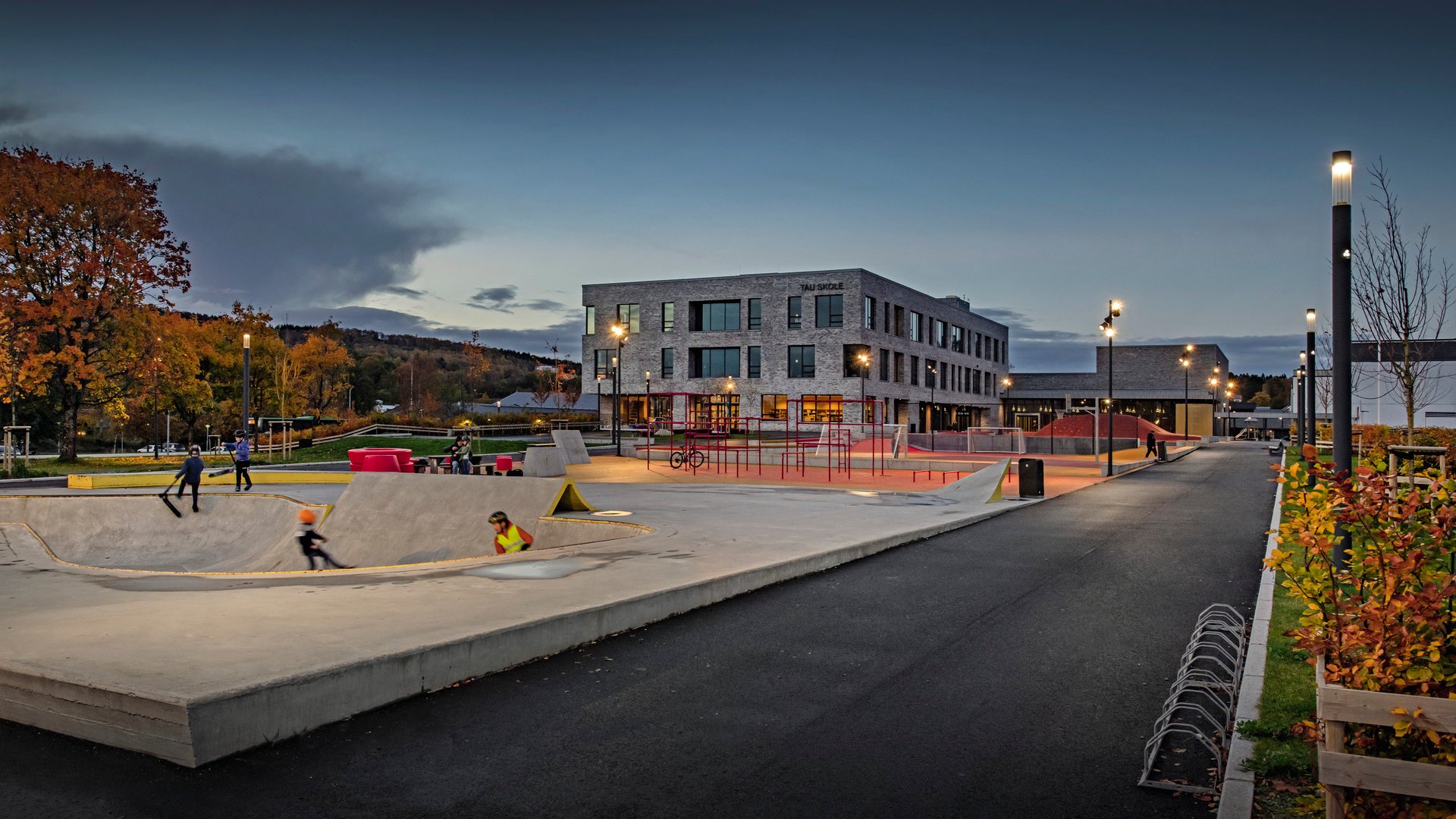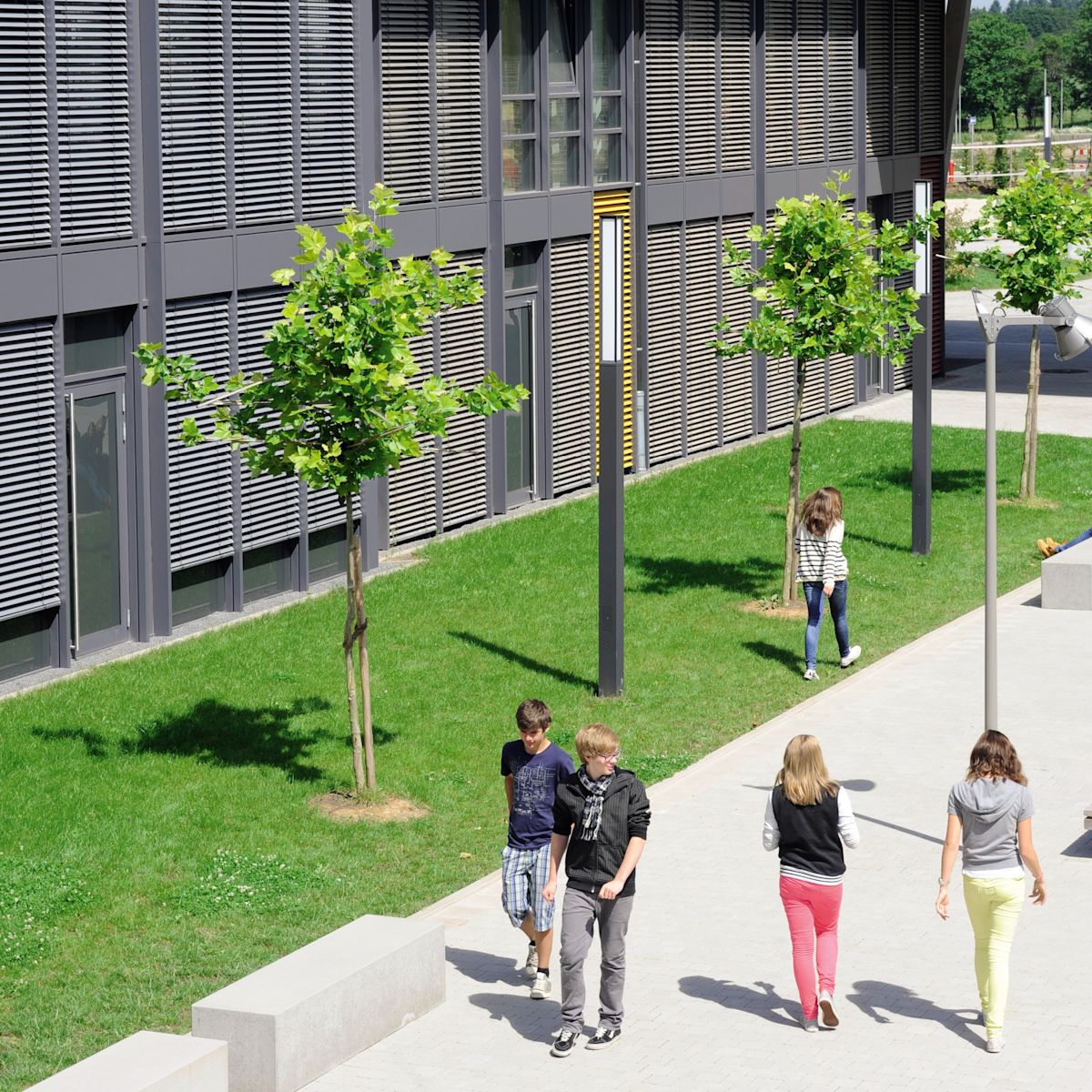
Creating open spaces for movement and relaxation: The campus, pathways and entrance areas are the “first impression” of every educational facility. Successful planning meets demand for secure and attractive lighting, and provides structure in areas where it’s easy to feel a little lost.
At the start of every lighting design process for schoolyards, play areas and pathways in educational facilities, there are clearly defined requirements: Light serves to guide the way and lead to entrances. It underlines and elevates the first impression of the area. Light also has a signalling effect in the illumination of obstacles, such as stairs or individual steps. A feeling of safety during daylight hours and after dark is provided by the structuring effect, as well as the effective light output of the luminaires. Furthermore, animating light from floodlights can be used to highlight certain areas or playground equipment for a sense of liveliness.
We deliver the solutions for the varied requirements of carefully coordinated illumination. Light control provides an even higher degree of user comfort, taking into account the questions: Where is continuous lighting needed after dark? Are all the requirements for emergency lighting and safety lighting covered? Where would sensors and dimming of the light at night be suitable and helpful? How can intuitive and inviting visitor guidance, e.g. for events, be achieved?



The unshielded light of bollard luminaires or light building elements, as well as the shielded light of bollard luminaires – if only the useful area is to be illuminated – provide many ways guide visitors to the entrances using the signalling effect of the luminaires.
Reliable automation of lighting can be achieved with the standardised, easy-to-install and user-friendly DALI protocol (Digital Addressable Lighting Interface). Twilight switching, motion sensors, dimming of the luminaires and different lighting scenarios, e.g. for events, can be programmed in advance and selected at the push of a button.
BEGA offers a complete range of DALI luminaires, sensors, input devices and controllers from a single source. In addition, a KNX-DALI gateway can be used to integrate the light control in a higher-level building management system.
Wherever existing buildings are to be modernised in an energy-efficient way and the light points are already determined by the original planning, the broad BEGA portfolio enables the selection of luminaires with light distributions that are precisely matched to the areas in use.
Another important issue regarding the use of luminaires in educational facilities: the risk of vandalism. That’s why we use extremely robust and durable materials in the production of our luminaires. They are additionally protected by our highly effective technologies, ensuring that they are not only resistant to vandalism, but fulfil the increased requirements in outdoor areas, such as dirt, weather influences and temperature fluctuations. This protection package is an integral part of our definition of quality, durability and ease of maintenance.
Quality for the schoolyard: form-giving illumination and operational safety
The luminaires make a statement in the dark and contributes to the design the welcome area and common room in many different ways.

Luminaires for schoolyards and campuses need to meet many different requirements. Their light provides safety and orientation. They must be robust. They accentuate the lines of the architecture. It is not the luminaire that makes the statement, but the building and the open space that are staged.
Illumination in these areas should be controllable according to safety-related, energy-efficient illumination criteria – taking into account the relevant standards.
Preset lighting scenarios can be selected with just one click, or the touch of a button for the purposes of general illumination, pathway navigation during evening events, or needs-based lighting (twilight switching, motion sensor). This simplifies and reduces the complexity of the school or university day.
BEGA luminaires fulfil every requirement in this area of use. Aesthetic quality and careful finishing of the components are just two aspects of a complete package that combines sophisticated illumination, operational safety and low maintenance.
A high protection class of at least IP 65 protects the outdoor luminaires against water jets and dust. With easy-to-install, flexible illumination, integrated in a DALI control protocol, the schoolyard or campus becomes a welcoming space – with an exceptionally long service life.
Interplay with the architecture
Spatial structure + visitor guidance
For educational facilities; the entrance areas, the campus and the routes through the spaces are determined by the architecture and the design of the outdoor facilities. These distinctive features of the institution are further structured by the lighting design and the route configuration by the light itself.
Drawing attention to prominent points, directing the eye to the entrance, designing the routes and conveying a sense of safety even in the dark – these are the tasks of well-planned illumination. The ability both to control the system and to predefine important lighting scenarios increases the convenience for those responsible for the facility and for the users alike.
Use of existing connections
One luminaire type – a wide range of applications with different light distributions
A schoolyard requires an average luminous intensity of 5-10 lx. When modernising a lighting system and using existing luminaire connections, it is necessary to find suitable luminaires with an appropriate light distribution.
The extensive BEGA portfolio offers numerous output levels and intelligently coordinated light distributions for almost all types of luminaire.
The comparison of one type of luminaire shows the following illuminated areas:





















